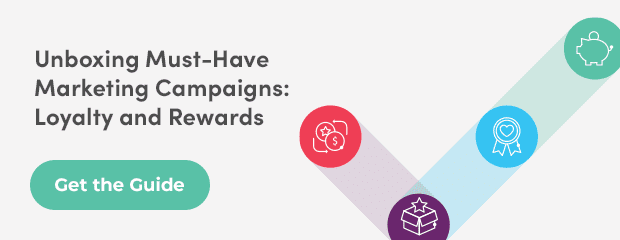In this ongoing series, we’ll be “unboxing” must-have digital marketing campaigns and programs vital to success. In this installment, we’ll look at loyalty and rewards.
Are you taking your brand’s best customers for granted?
As marketers, it’s too easy to focus our resources on acquiring new customers or reducing churn.
Because it also means your loyal fans—the ones who choose to spend their hard-earned money with your brand over and over—may not be getting the exclusive experience they deserve.
That’s why we’re going to focus on loyalty and rewards for this next edition of Unboxing Must-Have Marketing Campaigns.
Download the complete guide to understand why a successful loyalty or rewards program is more than an exclusive discount, and three ways to gamify customer rewards with cross-channel messaging.
As an introduction, let’s discuss the five principles you need to create a brand community and increase customer loyalty.
The Five Principles You Need to Create a Brand Community
When author Charles Vogl revealed how he successfully hosted a weekly dinner party for five years in The Art of Community, it surprised him at how many leaders approached him afterward to help them do the same.
Yet, his definition of what a community entails didn’t align with a for-profit organization’s need to make money and satisfy shareholders.
So alongside author Carrie Melissa Jones, the two of them created the brand community concept, which “aspires to serve both its members and at least one organizational (brand) goal.”
Jones and Vogl go on to further define the brand community by stating the following:
“Real communities are made up of relationships…although they may include transactionals, they are never purely transactional. They include generosity, at least the kind where we help others without calculating the return on investment (ROI) for sending a card, answering a timely question, or holding a door open for a stranger coming in from the cold…community relationships transcend transaction.”
While the generosity examples listed above may work for a brick-and-mortar business, doing the same online starts to get complicated.
Luckily, a designated loyalty and rewards campaign can communicate the same intentions of generosity, provided that they follow some of the Principles of Belonging that Vogl outlines his first book.
There are technically seven principles, but we at Iterable find that only five of them translate over to a marketing campaign.
They are:
- The Boundary Principle
- The Initiation Principle
- The Rituals Principle
- The Temple Principle
- The Inner Rings Principle
Let’s break them down, one by one.
1. The Boundary Principle
The first part of building any community is to create a boundary. To do this, a brand must determine a set of criteria on who is eligible to join your loyalty or rewards program and who isn’t.
For your B2C brand, that criteria could be a first-time purchase.
Or it can be an application process, like in the email example below from PayPal debit Mastercard.
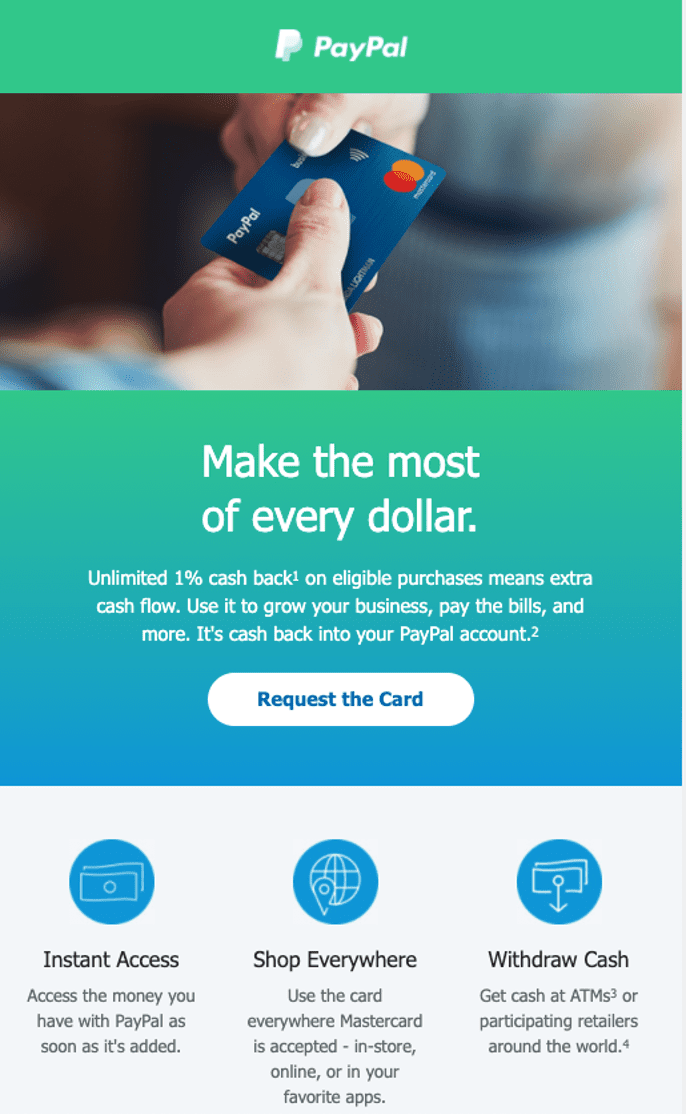

Online payment processor PayPal invites their business customers to receive 1% cashback if they apply for its debit Mastercard.
In this scenario, PayPal sends this email to business owners interested in 1% cashback on eligible purchases. The boundary used is the online form that requests specific information, like a birthdate and a social security number.
It’s unlikely that every customer you interact with is going to join your loyalty or rewards program. Therefore, it’s helpful to determine who your ideal customer segment is for a loyalty or rewards program, create a boundary like an application or a first-time purchase, and invite selected individuals to join accordingly.
2. The Initiation Principle
Once a customer joins your loyalty or rewards program, now comes the initiation. The customer has successfully crossed over the boundary and is now officially a member of the brand community.
While an initiation can be as simple as a loyalty-specific welcome or onboarding email campaign, author Charles Vogl states that the most impactful initiations include a ritual that comes with symbols and tokens.
For instance, let’s examine how Seattle-based PCC Community Markets initiates new members to their food co-op.
It’s important to note that PCC Community Markets is open to the public. However, PCC states in their mission that they exist to serve the members of the local community. If a frequent shopper chooses to cross the boundary and pay a one-time $60 fee, they start to accrue an annual dividend.
Once a new member joins, the below email example is sent with instructions on tracking their earnings.
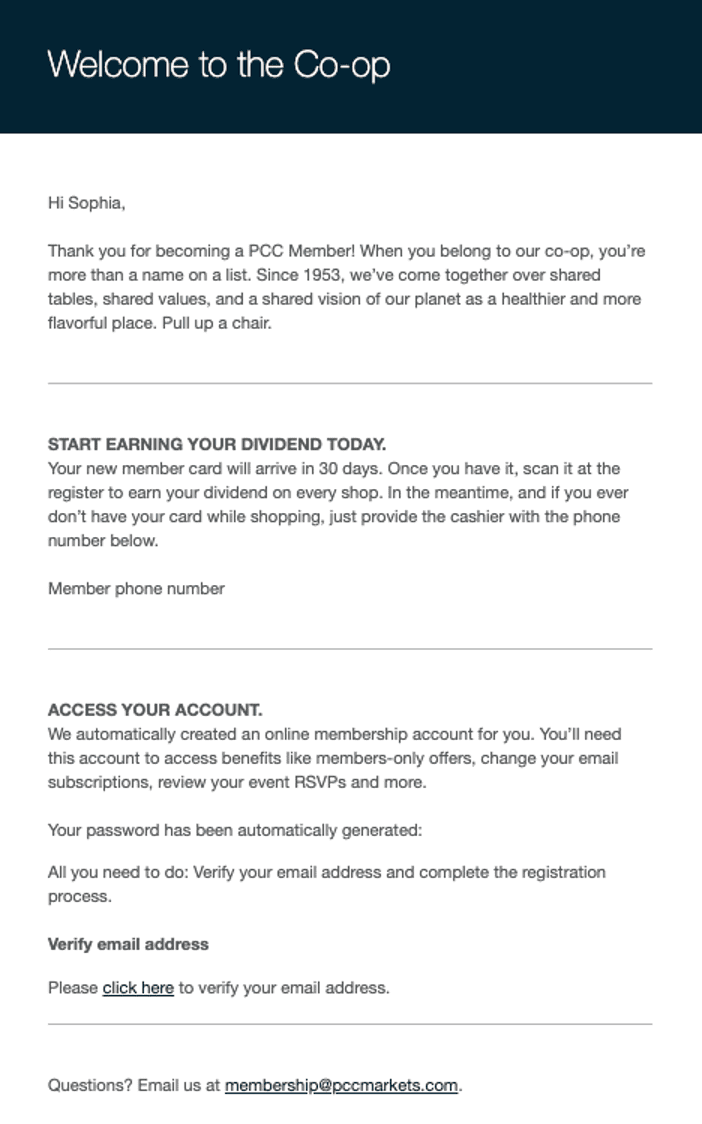

Local grocery store PCC Community Markets sends a welcome email to new members of their co-op.
While a phone number can be used to track purchases made in-store or via Instacart, PCC also makes a point to mail new members a physical membership card.
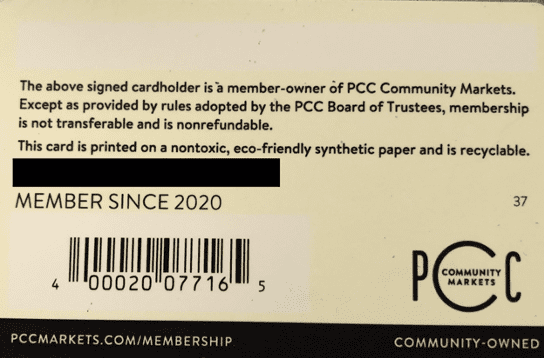

Local grocery store PCC Community Markets mails a physical membership to new co-op members.
Not only is it inexpensive for the brand to send a physical card, but it also serves as a token of initiation to the loyal customer who has crossed over the boundary to join the community.
3. The Rituals Principle
After initiation has taken place, now comes the part where brands excel: creating and celebrating at least one ritual, otherwise known as “a practice that marks a specific time or event as special or important.”
An example of a ritual for your family can be eating turkey on Thanksgiving or serving cake on a birthday. But for your brand, a ritual could be a customer milestone or a regularly occurring event, like a yearly sale.
For instance, outdoor retailer REI hosts its anniversary sale every spring. The public is free to shop there, but REI co-op members get a first look at the merchandise and receive exclusive coupons.


Outdoor retailer REI emails its co-op members a sneak peek at the upcoming Anniversary Sale, accompanied with exclusive coupons.
Inviting co-op members to view the anniversary sale merchandise before the public accomplishes the two following things:
- Alerts new members that this sale is an event or ritual to look forward to every year
- Rewards existing members for their continued loyalty and patronage
4. The Temple Principle
Every community must have a gathering place of sorts, otherwise known as a temple. Temples are important to communities because it is where like-minded members can talk to each other and share their values.
For e-commerce-only brands, this gathering place could be an online forum or chat room. For retailers with a physical storefront, they can encourage their customers to visit a nearby location to view new inventory or attend an exclusive event.
But let’s say your brand is a restaurant, like the email sent below from fast-casual chain Bahama Breeze.
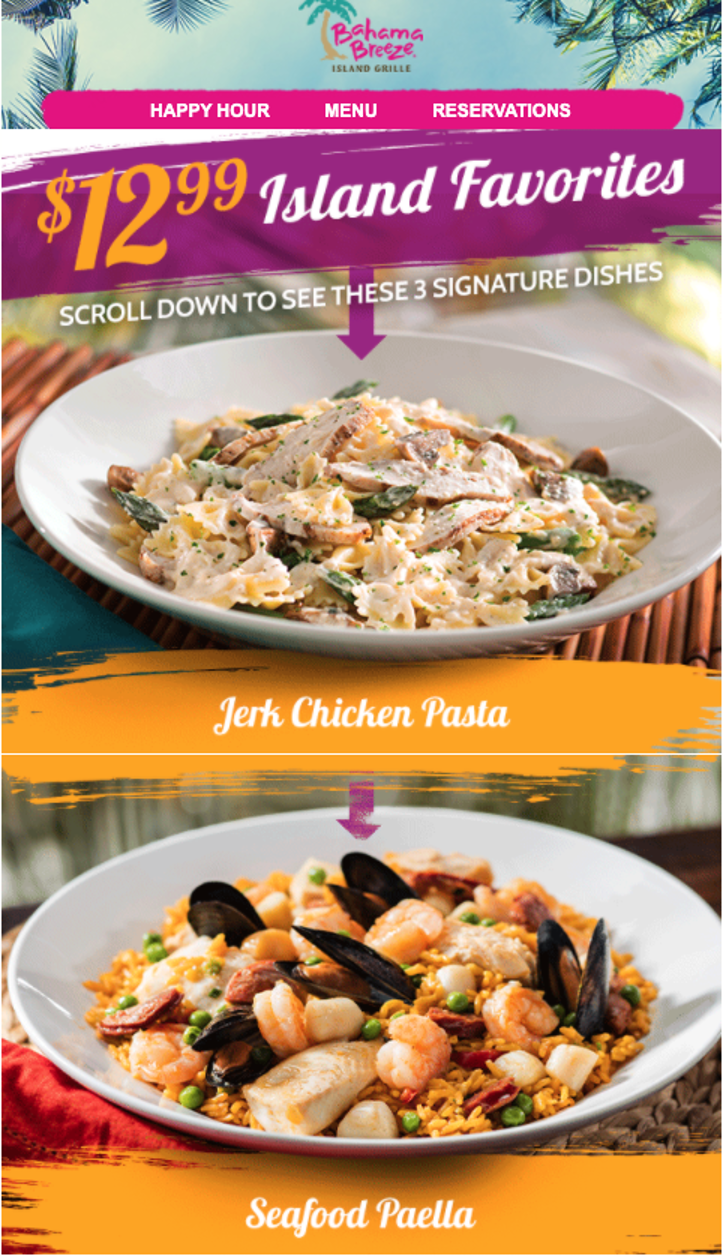

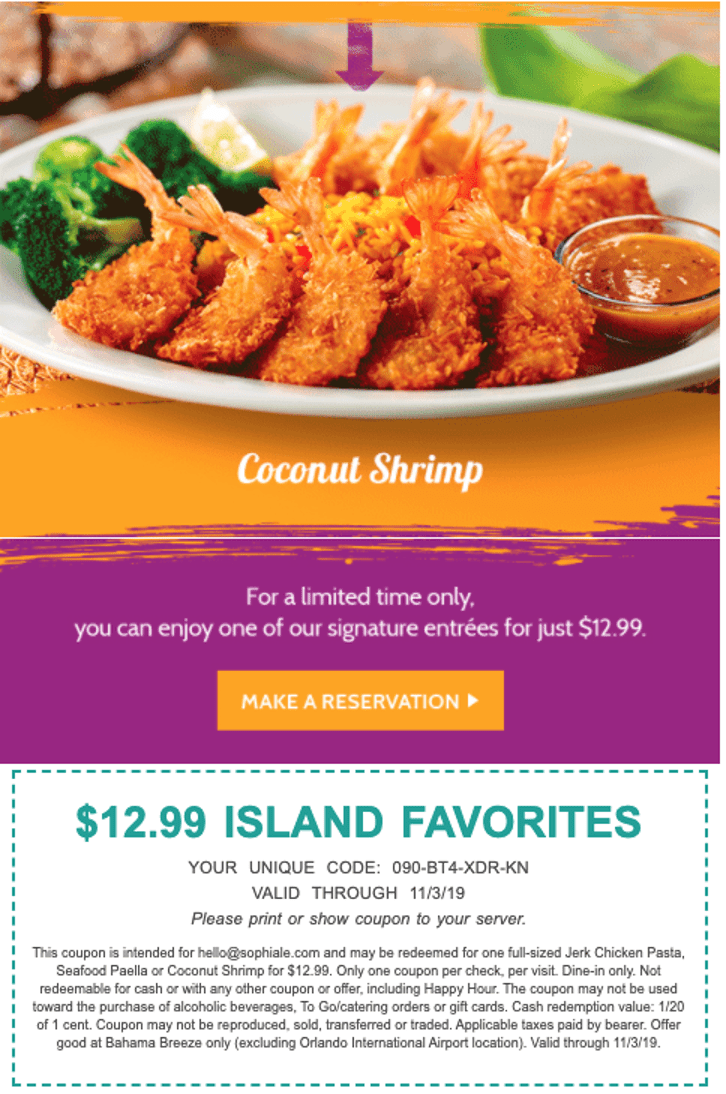

Fast-casual dining chain Bahama Breeze emails an exclusive coupon to its Island Insiders to use towards their next dine-in visit.
Typically, Bahama Breeze offers an Island Insiders loyalty program for new customers, in exchange for a coupon on their next dine-in visit. However, with the restrictions placed on restaurants and other brick-and-mortar businesses during the COVID-19 outbreak, brands need to evolve and adapt.
It may seem impossible to encourage customers to gather at a physical location while also complying with government social distancing guidelines. But one way to fulfill the temple principle would be to offer extra perks and rewards to loyalty program members who pick up products via curbside instead of utilizing a delivery service.
5. The Inner Rings Principle
Last but not least, a thriving brand community needs to have an inner ring, which are the tiers or levels in a loyalty or rewards program. Without an inner ring, members won’t know how to progress their relationship with the community, or get rewarded for their status.
In the case of candy retailer Sugarfina, they define a set of points between 0-500 that a rewards member can achieve within the year.
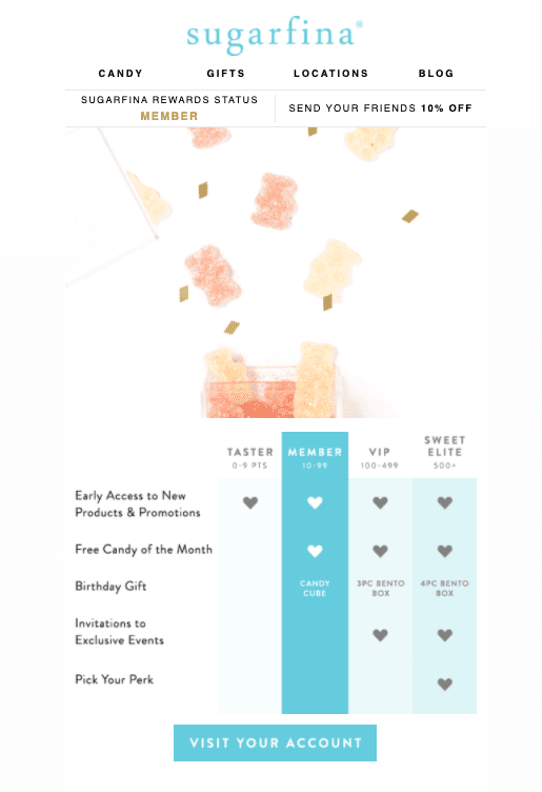

Candy retailer Sugarfina uses email to notify a rewards member of their current points status so far this year.
As a rewards member collects more points, the type of rewards they receive changes. For instance, Sugarfina states above that a customer needs at least 100 points or more to start receiving invitations to exclusive events.
According to Charles Vogl, having an inner ring as part of your brand community is essential because:
“We all aspire to belong to prestigious inner rings, perhaps not just for authority and respect but for new ways to participate and contribute.”
To Sum It All Up
Setting up a loyalty or rewards program for your best customers is a no-brainer for any marketer.
However, it’s more than just tracking what they spend or giving an exclusive discount—it’s creating a brand community.
We at Iterable recommend using some or all of Charles Vogl’s Principles of Belonging when creating your loyalty program and marketing campaigns.
The principles are:
- The Boundary Principle
- The Initiation Principle
- The Rituals Principle
- The Temple Principle
- The Inner Rings Principle
And if your brand has a mobile app or wants to experiment with other cross-channel mediums, download our full guide to learn how to utilize text messaging (SMS), in-app messaging and mobile push notifications.
Now that you have the skills and knowledge to create an engaging loyalty and rewards campaign, what are you going to do to make sure your best customers aren’t taken for granted?






























